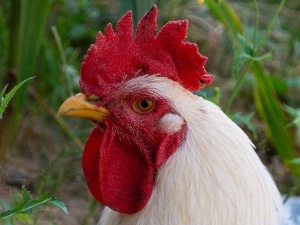
Chickens cannot communicate with humans to tell us what they’re thinking or how they’re feeling, but we can determine what’s happening with the bird through their actions and their appearance.
If your bird’s appearance starts to change, if it develops black scabs on its comb, then you’d be right to worry
Table of Contents
Black scabs on chicken comb:
A chicken’s comb can communicate a lot about the bird. Chicken combs are usually full, red, firm, and bright. If your bird’s comb starts to develop black scabs then the bird likely has dry fowl pox
What is fowl pox?
Fowl pox is a viral infection that can affect chickens, turkeys, and a variety of other birds. It is a common issue in Australia in particular and is especially common during the summertime.
There are two types of fowl pox, wet fowlpox, and dry fowlpox. Wet fowl pox affects the bird’s throat and respiratory tract. Dry fowl pox affects the bird’s head, legs, comb, wattles, and body.
Dry fowlpox causes scabs to develop on the non-feathery parts of your bird. Wet fowl pox causes plaques to develop in the bird’s upper respiratory tract and mouth, these can cause chickens to develop breathing difficulties and suffocate.
Dry fowlpox is not as fatal as wet fowlpox, wet fowlpox can suffocate and kill your bird.
A bird can suffer from dry fowlpox or wet fowlpox, or, it can suffer from both at the same time.
Symptoms:
If your bird has dry fowl pox then the bird may develop other symptoms namely:
- Listlessness
- Weight loss
- Loss of appetite or thirst
- Some lethargy
- Reduced egg production
How it’s spread:
Fowl pox can spread to healthy chickens from sick chickens, through mosquito bites, or on contaminated equipment.
Also, when the scabs of birds who have dry fowlpox drop, other birds may pick the scabs up, eat them, and will become infected with this disease. These scabs contain the pox virus and are infectious.
The scabs can also drop and form a powder, if the other birds inhale this powder, they will become infected with this disease.
How does fowl pox progress?
Once your bird becomes infected with dry fowl pox the bird will develop lesions or sores on the non-feathery parts of its body, that being the face, wattles, legs, beaks, eyes, earlobes, and the comb.
These lesions will start off as small bumps which will pop open and secrete pus. They will then grow and turn yellow and will then eventually turn into black scabs as they roughen up.
These scabs will dry up and fall off after about two or three weeks. Smooth pink scar tissue will be left where the scabs were.
Wet pox develops and progresses in the bird’s throat and mouth.
In the case of wet pox, the bird will develop cheesy and white patches in its throat and mouth. These patches will eventually block the bird’s airways to a point where suffocation happens, the bird’s trachea will also begin to look inflamed.
Treatment options:
Unfortunately, there is no cure for fowl pox, but the bird should recover on its own in a couple of weeks.
The best thing that you can do for a bird suffering from this ailment is to give the bird supportive care as it fights the fowlpox off, treat it medically if it develops a secondary infection
Isolate the bird:
Isolating a bird that you think has fowlpox is recommended. This will keep this bird from infecting other members of the flock.
Treatments:
Applying iodine directly onto the scabs will help them heal, dry off, and fall off sooner than expected.
Using a first aid salve, like manuka honey or cetrigen will also help. Giving the bird, as well as the rest of the flock, vitamins to keep their immune systems in the best shape is also recommended.
Cleaning:
Cleaning and disinfecting the area, as well as cleaning and disinfecting your bird’s feeder and waterers, is recommended. Use oxine to clean the area and add this to your birds drinking water as well.
Antibiotics:
Your vet will prescribe antibiotics for your bird if it develops a secondary infection.
Only give your bird the antibiotics that your vet prescribes, giving your bird something else will be inappropriate and even dangerous for your bird.
Note: Do not give your bird too many rounds of antibiotics in its lifetime, this can cause antibiotic resistance in your bird.
If you enjoyed this article then you may also be interested in other bird related articles. Here are some articles that you may be interested in: Sores On Chicken’s Comb, Lump On Chicken’s Beak, Wart On Chicken Beak

